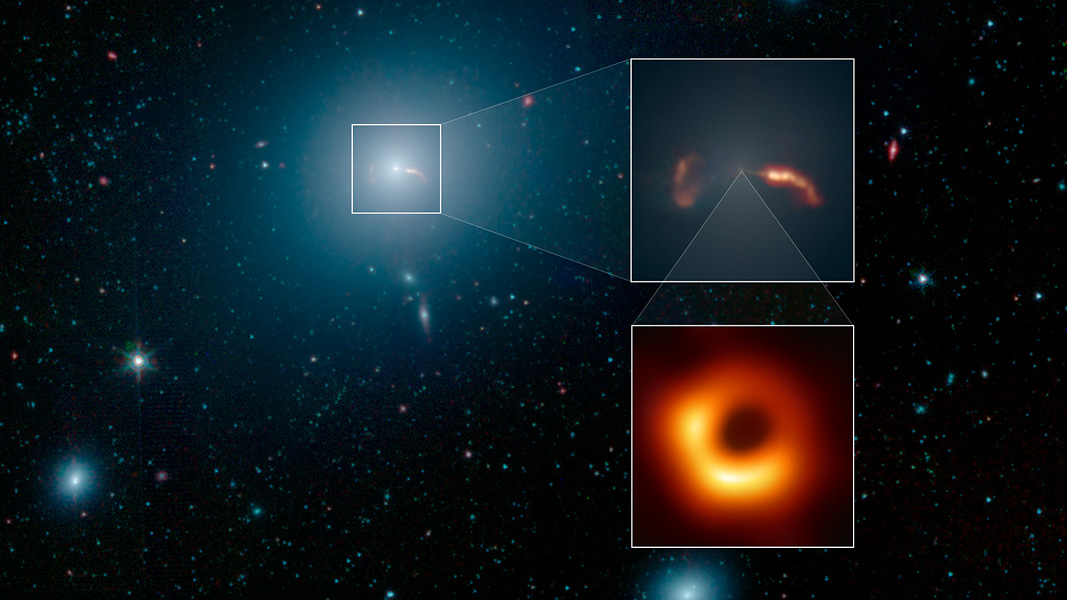2023年5月4日
The Galaxy, the Jet, and a Famous Black Hole
Image Credit: NASA, JPL-Caltech, Event Horizon Telescope Collaboration
Explanation: Bright elliptical galaxy Messier 87 (M87) is home to the supermassive black hole captured in 2017 by planet Earth’s Event Horizon Telescope in the first ever image of a black hole. Giant of the Virgo galaxy cluster about 55 million light-years away, M87 is the large galaxy rendered in blue hues in this infrared image from the Spitzer Space telescope. Though M87 appears mostly featureless and cloud-like, the Spitzer image does record details of relativistic jets blasting from the galaxy’s central region. Shown in the inset at top right, the jets themselves span thousands of light-years. The brighter jet seen on the right is approaching and close to our line of sight. Opposite, the shock created by the otherwise unseen receding jet lights up a fainter arc of material. Inset at bottom right, the historic black hole image is shown in context, at the center of giant galaxy and relativistic jets. Completely unresolved in the Spitzer image, the supermassive black hole surrounded by infalling material is the source of enormous energy driving the relativistic jets from the center of active galaxy M87. The Event Horizon Telescope image of M87 has now been enhanced to reveal a sharper view of the famous supermassive black hole.
At NASA: Black Hole Week
Tomorrow’s picture: ShadowCam
星系、喷流与著名的黑洞
影像提供: NASA, JPL-Caltech, Event Horizon Telescope Collaboration
说明: 明亮的椭圆星系梅西叶87(M87)核心之超大质量黑洞,是地球上的事件视界望远镜,在2017年拍摄有史以来首张黑洞影像的主角。 M87是大约在5500万光年外的室女星系团的庞大成员星系,而在这张来自斯皮策太空望远镜的红外光底图里,M87是其中以蓝色阶呈现的大星系。虽然M87看起来像一团云而且几乎没有特征,但斯皮策的影像,却能清楚的记录了从此星系核心区射出的相对论性喷流之细节。右上角的嵌图中显示,这些喷流本身长达数千光年。嵌图右方较明亮的喷流,指向我们而且离我们的视线方向不远。与其反向的不可见的远离喷流,冲击并激发一个物质弧发出淡淡的辉光。右下角的嵌图,则呈现上文所提到的、位于庞大星系及相对性喷流中心的黑洞之历史性影像。在斯皮策的影像里完全无法解析的,是被超大质量黑洞吸积在周围的内坠物质环,而它们则是驱动源自活跃星系M87中心的相对论喷流之庞大能量源。M87的事件视界望远镜影像现在已经过强化,得以更清晰的呈现这个著名的超大质量黑洞。
在NASA: 黑洞周
明日的图片: ShadowCam







